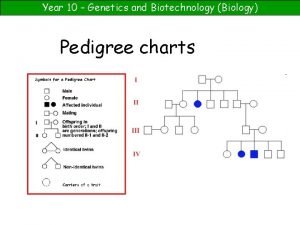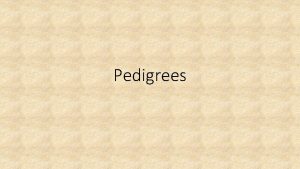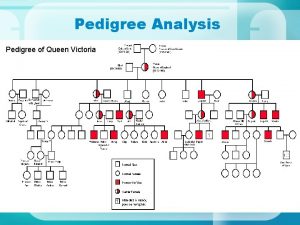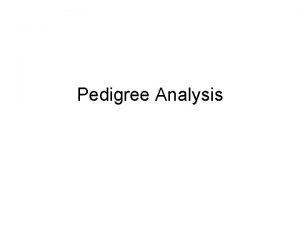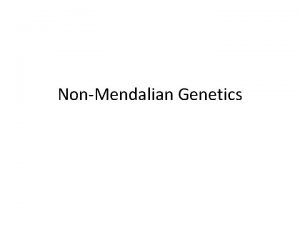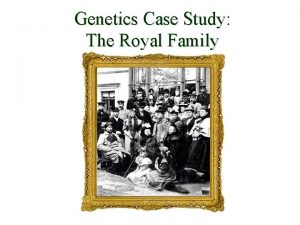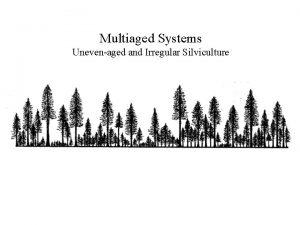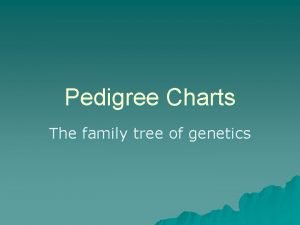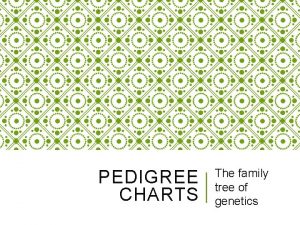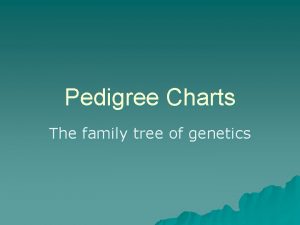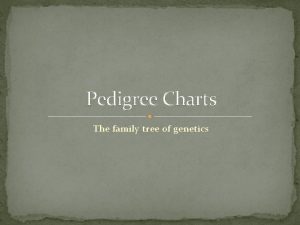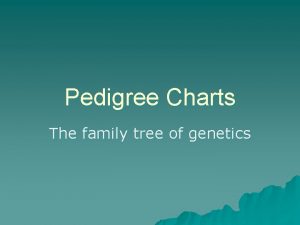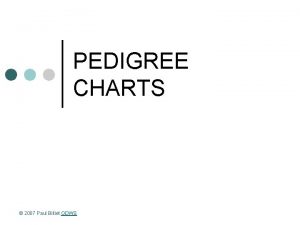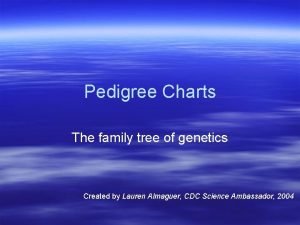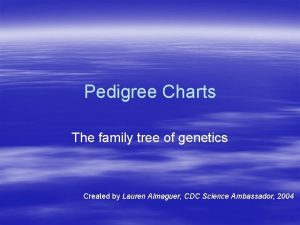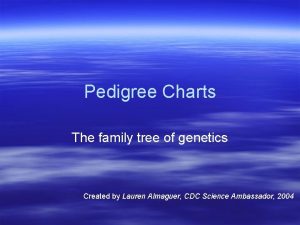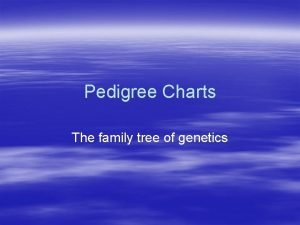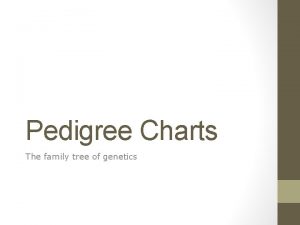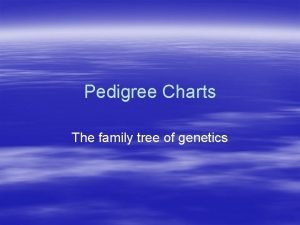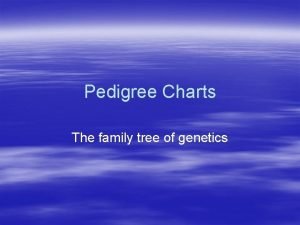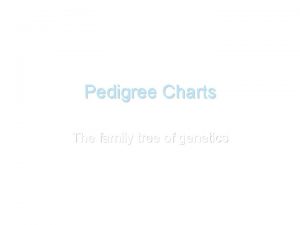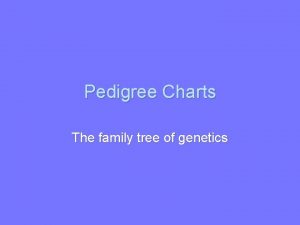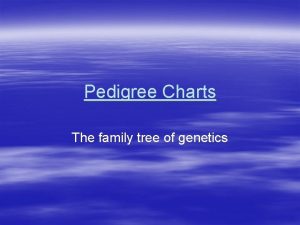PEDIGREE CHARTS THE FAMILY TREE OF GENETICS Created




















![PEDIGREE CHART -CYSTIC FIBROSIS [Created by Lauren Almaguer, CDC Science Ambassador, 2004. ] PEDIGREE CHART -CYSTIC FIBROSIS [Created by Lauren Almaguer, CDC Science Ambassador, 2004. ]](https://slidetodoc.com/presentation_image_h2/3b32ee78bd884f431072a62cc1728fc6/image-21.jpg)
- Slides: 21

PEDIGREE CHARTS THE FAMILY TREE OF GENETICS [Created by Lauren Almaguer, CDC Science Ambassador, 2004. ]

VOCAB • Autosomal gene- a gene found on any chromosome except for the sex chromosome. These are chromosomes numbered 1 -22. • X-linked gene- a gene found on a chromosome designated as a sex chromosome (X or Y). • Dominant- Refers to an allele that is expressed phenotypically and masks any recessive counterpart. • Recessive- An allele that is not phenotypically expressed when its counterpart is dominant. [Created by Lauren Almaguer, CDC Science Ambassador, 2004. ]

PEDIGREE CHARTS 3 11 4 12 13 5 6 14 15 I 2 1 8 7 16 10 9 17 18 II 19 III [Created by Lauren Almaguer, CDC Science Ambassador, 2004. ]

WHAT IS A PEDIGREE? • A pedigree is a chart of the genetic history of family over several generations. • Scientists or a genetic counselor would find out about your family history and make this chart to analyze. • For example, a couple might like to know their chances of having a child that has muscular dystrophy. So the scientists or a genetic counselor would find out who had muscular dystrophy in the mother’s and/or father’s families. This information would be used to and then calculate the probability of the couple having a child with MD. [Created by Lauren Almaguer, CDC Science Ambassador, 2004. ]

CONSTRUCTING A PEDIGREE You must learn the symbols of the pedigree charts before you can start to learn how to interpret it. These are the symbols that represent a male and a female. • Female • Male [Created by Lauren Almaguer, CDC Science Ambassador, 2004. ]

CONNECTING PEDIGREE SYMBOLS Examples of connected symbols: Fraternal Twins Identical Twins Here are examples of symbols that represent relationships between people. [Created by Lauren Almaguer, CDC Science Ambassador, 2004. ]

CONNECTING PEDIGREE SYMBOLS (RELATIONSHIP) Examples of connected symbols: • Married Couple • Siblings These symbols also represent relationships between people some may have to each other. [Created by Lauren Almaguer, CDC Science Ambassador, 2004. ]

EXAMPLE • What does a pedigree chart look like? This is just an example of a pedigree and there can be many more different types. [Created by Lauren Almaguer, CDC Science Ambassador, 2004. ]

SYMBOLS IN A PEDIGREE CHART • Affected • X-linked • Autosomal carrier • Deceased [Created by Lauren Almaguer, CDC Science Ambassador, 2004. ] These are examples of different types of symbols. These symbols would be the same for males or females, except for X-linked carrier which is only used for females. So an affected male would be a square that is filled in completely. A deceased female would be a circle with a diagonal slash.

INTERPRETING A PEDIGREE CHART • When interpreting a pedigree chart of a family with a disease like muscular dystrophy, it is important to consider two steps. The first is to determine if the disorder is autosomal or X-linked. • If the disorder is X-linked most of the males will have the disorder because the Y-chromosome cannot mask the affects of an affected X-chromosome. A female can have the disorder, but it would be a very low percentage. For a female to be affected, she would have had to receive an affected gene from the mother and the father. This means that the father would have the disorder and the mother was a carrier. [Created by Lauren Almaguer, CDC Science Ambassador, 2004. ]

INTERPRETING A PEDIGREE CHART (CONT. ) • In an autosomal disorder, the disorder is not found on the X or Y chromosome. It is found on the other 22 chromosomes in the human body. • This means that men and women have an equal chance of having the disorder. The mother and father can be homozygous dominant, heterozygous, and homozygous recessive. • If a person is homozygous dominant, the person has two of the same dominant genes. • For example if someone is homozygous dominant for being tall it may be represented as TT. Capital letter always represent a dominant gene. • If a person is heterozygous, this person would have a dominant trait and a recessive trait. It may be represent as Tt. The dominant gene will mask the recessive gene, so the person is still tall. • If a person is homozygous recessive, the person has two of the same recessive genes. • For example if someone is homozygous recessive for height, it may be represented as tt. The tt would mean the person is short. [Created by Lauren Almaguer, CDC Science Ambassador, 2004. ]

INTERPRETING A PEDIGREE CHART (CONT. 2) 1. Determine if the pedigree chart shows an autosomal or X-linked disease. • If most of the males in the pedigree are affected the disorder is X-linked • If it is a 50/50 ratio between men and women the disorder is autosomal. [Created by Lauren Almaguer, CDC Science Ambassador, 2004. ]

EXAMPLE OF PEDIGREE CHARTS L A M O S • Is it Autosomal or X-linked? O T U A Take a minute and try to decide if this slide is autosomal or X-linked. [Created by Lauren Almaguer, CDC Science Ambassador, 2004. ] It is autosomal because it is 50/50 men to women with the disorder, if it was X-linked most of the men in the diagram would have the disorder. Make sure you count the number of men with the disorder and the number of women with the disorder. In this pedigree, 3 men and 3 women have the disorder.

INTERPRETING A PEDIGREE CHART 2. Determine whether the disorder is dominant or recessive. • If the disorder is dominant, one of the parents must have the disorder. • If the disorder is recessive, neither parent has to have the disorder because they can be heterozygous. [Created by Lauren Almaguer, CDC Science Ambassador, 2004. ]

DOMINANT OR RECESSIVE? • The second step is to determine if the disorder is dominant or recessive. It is important to find out if a disorder is dominant or recessive. • For example, Huntington’s disease is a dominant disorder. • If you have only one dominant gene you will have Huntington’s disease, which is a lethal disorder. • The disorder does not show up until a person is in their middle ages such as 45. It will quickly decrease their motor skills and the brain will begin to deteriorate. [Created by Lauren Almaguer, CDC Science Ambassador, 2004. ]

DOMINANT? • If a disorder is dominant, one parent must have the disorder (either homozygous dominant (TT) or heterozygous recessive (Tt). • Both parents do not have to have the disorder. • One parent might not have the disorder or be a carrier. • If a disease is dominant, it does not skip a generation unless one parent is heterozygous dominant (Tt) and the other parent is homozygous recessive (tt). • In this case the child has a chance of not receiving the dominant gene. [Created by Lauren Almaguer, CDC Science Ambassador, 2004. ]

RECESSIVE • If the disorder is recessive, a parent does not have to have the disorder, but could still pass it to their offspring. • This would happen when a parent is heterozygous recessive (Tt) and passes on the recessive (t) gene. • This means this disorder can skip generations. An example of a recessive disorder would be sickle cell anemia. [Created by Lauren Almaguer, CDC Science Ambassador, 2004. ]

EXAMPLE OF PEDIGREE CHARTS (2) T N • Dominant or Recessive? D A N I M O Is this pedigree dominant or recessive? [Created by Lauren Almaguer, CDC Science Ambassador, 2004. ] It is dominant because a parent in every generation have the disorder. Remember if a parent in every generation has the disorder, the disorder has not skipped a generation. If the disorder has not skipped a generation the disorder is dominant.

EXAMPLE OF PEDIGREE CHARTS (3) E IV • Dominant or Recessive? E C E R [Created by Lauren Almaguer, CDC Science Ambassador, 2004. ] S S It is recessive because a parent in every generation does not have the disorder. Remember the disorder can skipped a generation if the disorder is recessive. The parents can be heterozygous and be carriers of the disorder but not have the symptoms of the disorder.

SUMMARY • Pedigrees are family trees that explain your genetic history. • Pedigrees are used to find out the probability of a child having a disorder in a particular family. • To begin to interpret a pedigree, determine if the disease or condition is autosomal or X-linked and dominant or recessive. [Created by Lauren Almaguer, CDC Science Ambassador, 2004. ]
![PEDIGREE CHART CYSTIC FIBROSIS Created by Lauren Almaguer CDC Science Ambassador 2004 PEDIGREE CHART -CYSTIC FIBROSIS [Created by Lauren Almaguer, CDC Science Ambassador, 2004. ]](https://slidetodoc.com/presentation_image_h2/3b32ee78bd884f431072a62cc1728fc6/image-21.jpg)
PEDIGREE CHART -CYSTIC FIBROSIS [Created by Lauren Almaguer, CDC Science Ambassador, 2004. ]
 Pedigree chart biology
Pedigree chart biology Pedigree structure
Pedigree structure Pedigrees practice
Pedigrees practice Hearsay evidence examples
Hearsay evidence examples Symbols in pedigree
Symbols in pedigree Family pedigree of queen victoria
Family pedigree of queen victoria How to identify sex-linked traits from pedigree
How to identify sex-linked traits from pedigree Flipnob family pedigree answer key
Flipnob family pedigree answer key Romanov family pedigree
Romanov family pedigree Highest point of a wave
Highest point of a wave Oldest tree created using
Oldest tree created using Hình ảnh bộ gõ cơ thể búng tay
Hình ảnh bộ gõ cơ thể búng tay Slidetodoc
Slidetodoc Bổ thể
Bổ thể Tỉ lệ cơ thể trẻ em
Tỉ lệ cơ thể trẻ em Chó sói
Chó sói Chụp phim tư thế worms-breton
Chụp phim tư thế worms-breton Bài hát chúa yêu trần thế alleluia
Bài hát chúa yêu trần thế alleluia Các môn thể thao bắt đầu bằng tiếng nhảy
Các môn thể thao bắt đầu bằng tiếng nhảy Thế nào là hệ số cao nhất
Thế nào là hệ số cao nhất Các châu lục và đại dương trên thế giới
Các châu lục và đại dương trên thế giới Công thức tiính động năng
Công thức tiính động năng
